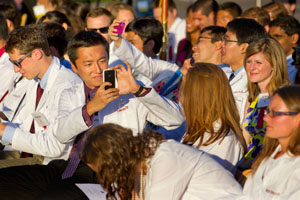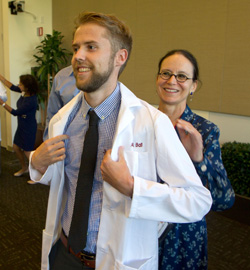September 9, 2013 - By Tracie White

During orientation, the first-year medical students were urged to pull out their smart phones and take photos of one another to help them remember this moment in the future.
The first-year medical students, having just donned their white coats, already have a claim to fame: They comprise the largest class in the School of Medicine's history.
These 102 students — 10 more than matriculated last year — began classes Aug. 26.
The new class is made up of 47 women and 55 men. Twenty-three were born outside the United States, including nine in China and five in South Korea.
Fifteen of the students already hold advanced degrees: 10 have master's degrees, and five have PhDs. Fourteen earned bachelor's degrees in nonscience majors. The students come from 39 different colleges and universities. Stanford, as usual, tops this list, with 19 students. There are also 11 from Yale, 11 from Harvard and seven from MIT. Eight of the students participated in varsity athletics, and one-third have published in a peer-reviewed journal. The class also includes co-matriculating twin sisters Tiffany and Stephanie Chen, both biology majors from MIT.

Lloyd Minor, dean of the medical school, welcomes new student Victoria Boggiano on Aug. 23 during orientation.
"The new class is a truly amazing group of people," said Lloyd Minor, dean of the medical school. "Full of passion and driven by a desire to have an impact, these future physicians will not just provide outstanding patient care, they will transform the way that care is delivered. It is a honor to welcome them to Stanford Medicine."
The modestly bigger class was the result of a higher-than-expected acceptance rate among applicants who were offered admission, said Charles Prober, MD, senior associate dean for medical education.
Approximately 180 were offered admission from an applicant pool of more than 7,300. The school generally aims each year to enroll about 90 medical students, which again will be the target in 2014.
"Our philosophy is to stay small so that we can provide an optimized journey for each of our students," Prober said. Stanford enrolls fewer first-year medical students than many of its peers, such as Harvard and University of California-San Francisco, both of which generally enroll about 165.
To account for this year's larger class size, an additional faculty member was recruited for the Educators-4-Care program, which is designed to teach physical examination skills and other hands-on techniques. The program's faculty members act as mentors, providing students with ongoing training in the doctor/patient relationship throughout their Stanford careers. They teach how to approach a patient with a thoughtful understanding of the patient's history and expose students to actual clinical settings early in their education.

Paula Hillard, professor of obstetrics and gynecology, robes student Alexander Ball with his white coat.
The students prepared for the start of school with an orientation program that included what has become a traditional presentation, titled "The Search for Meaning in a Medical Life: Lessons from the Early AIDS Era," delivered by Abraham Verghese, MD, senior associate chair for the theory and practice of medicine and bestselling author of the novel Cutting for Stone and the nonfiction book My Own Country: A Doctor's Story.
The annual medical school stethoscope ceremony, designed to symbolize the importance of the physical connection between doctor and patient, was held Aug. 23. In another ceremony, the students received white coats, the traditional garb of the health professions.
In addition to anatomy — which for many of these students will be their first-ever dissection of a human cadaver — their curriculum includes courses in applied biochemistry, genetics, development and disease mechanisms and the molecular foundations of medicine.
About Stanford Medicine
Stanford Medicine is an integrated academic health system comprising the Stanford School of Medicine and adult and pediatric health care delivery systems. Together, they harness the full potential of biomedicine through collaborative research, education and clinical care for patients. For more information, please visit med.stanford.edu.